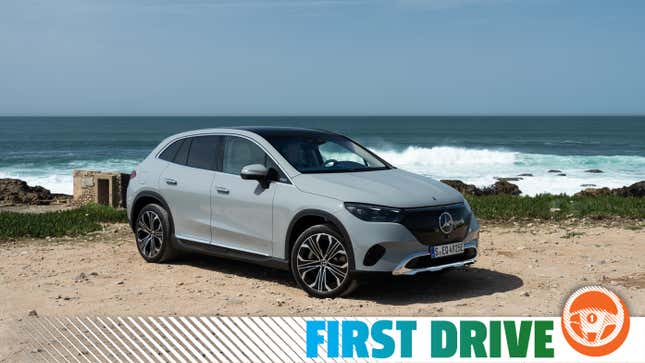
In the battle of aesthetics versus aerodynamics, there are winners and there are losers. In the eyes of many, myself included, the Mercedes-Benz EQE electric sedan sits squarely in that latter category. Anonymous to the extreme, its ambiguous shape simply disappears in a busy parking lot. That doesn’t stop it from being a fantastic car with good performance, solid range, and a refined ride, but it just isn’t much to look at.
When I first saw the Mercedes-Benz EQE SUV, I confess I didn’t think much of it, either. It is, after all, just a taller EQE with a hatch. But, after spending a few days motoring around in one, contemplating it in a variety of settings while sitting in the Portuguese sun (the car, not me), I confess I’ve changed my tune. I genuinely think the EQE SUV is a big visual upgrade.
Full Disclaimer: Mercedes-Benz wanted me to drive the EQE SUV so badly, the company flew me to Lisbon, Portugal, put me up in not one but three posh hotels, and plied me with all the vegan beetroot carpaccio I could eat.
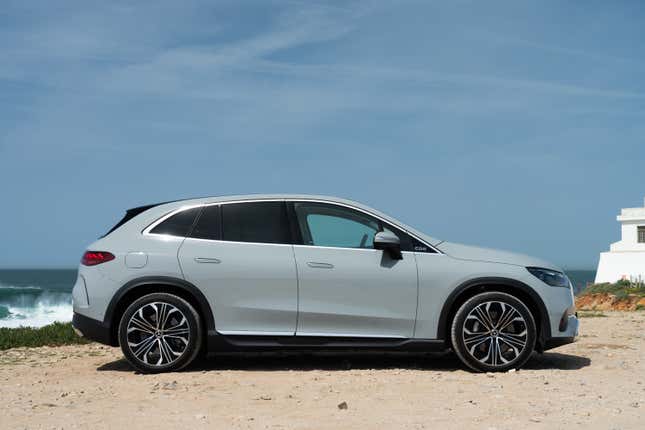
Both EQE models share the same general style signature: A swooping black plastic nose surrounding the Mercedes-Benz logo. The black faux-grille on the EQE sedan just sort of eases its way into the hood, which to me is a big part of what makes the sedan so anonymous-looking. On the EQE SUV, there’s a sharper definition between grille and hood, front and top, that gives the electric crossover just a smidge more personality.
It’s much the same story at the rear. Where the sedan’s roofline lazily arcs down right into the rear bumper, the SUV’s terminal end is more defined, thanks to the liftgate and the pert little spoiler that hangs from it.
To be clear, the EQE SUV is no stunner. Nobody’s going to go fumbling for their phone to snap a picture when this crossover idles by on a busy street. But it does at least have some presence that the sedan largely lacks.
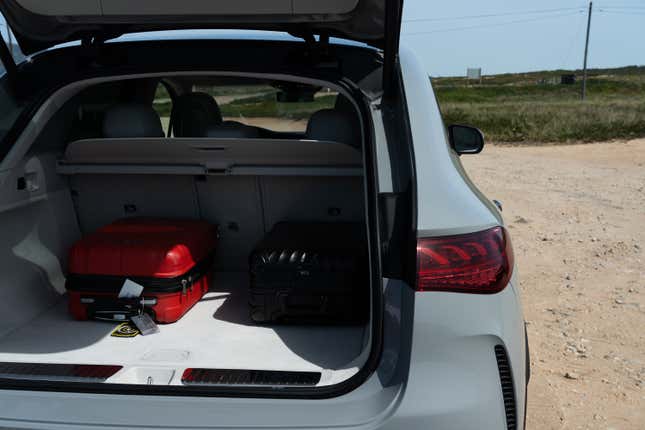
Another thing the EQE SUV has over the sedan, of course, is cargo space. The rear hatch opens onto a volume that’s far more conducive to long road trips or big dogs. There’s 20 cubic feet of space with the seats up, to be exact, growing to 59 with the rear seats folded. That compares unfavorably to the Tesla Model Y’s 34.3 cubic feet with the seats up, or 76.2 with them folded. (The Tesla also has a frunk, which the EQE lacks.) One point in favor of the Mercedes: Those rear seats are split 40/20/40, making it easy to get bigger cargo like skis or snowboards in there while still carrying two rear passengers.
Getting those passengers into the rear seats is also easier here than in the sedan. The higher roofline and generally more spacious layout make the back a much more comfortable place. The front is roomy, too. The EQE sedan always felt a bit claustrophobic to me, but after two days of driving around in the EQE SUV, in models with and without the massive panoramic glass roof, I never had that same hemmed-in feeling.
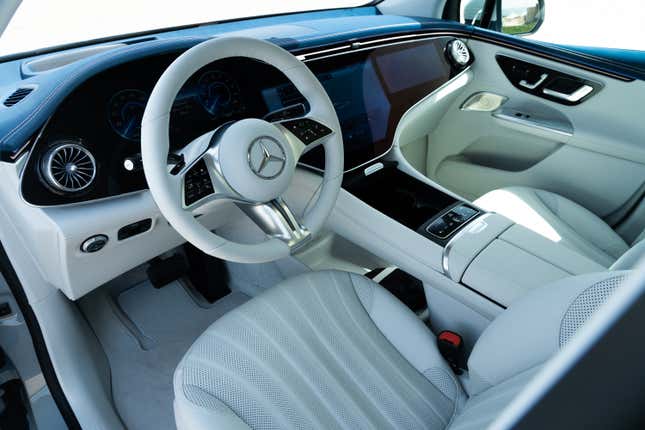
The best seats are up front, though, and if you don’t mind paying a little extra, they’ll even massage you. (They’re an $1,100 option on the EQE sedan, and should cost about the same here.) The standard 12.8-inch, vertically oriented display is large enough to make it easy to navigate through the endless options and configurable features on the EQE. Likewise, the 12.3-inch virtual gauge cluster is extensively tweakable, but it’s all simple and easy to do. Mercedes’ MBUX interface does a great job of putting buttons and options where you expect them, rather than burying them in endless menus.
While the taller, prouder SUV profile makes room for more of that lovely interior, there are some drawbacks, the biggest being a reduction in aerodynamics. The EQE sedan has a remarkably slippery 0.20 coefficient of drag. The EQE SUV, on the other hand, drops to 0.25. That’s still very good, but the extra resistance to the wind, plus a little extra weight (5,300 pounds vs. 5,201 for the sedan, when both are 350+ models), has an unfortunate impact on range. At best, with the rear-wheel-drive EQS SUV 350+, you’re looking at 279 miles of battery range per the EPA. At worst, with the 350 4Matic, it’s 253 miles. The 500 4Matic splits the difference at 269 miles. All versions use a 90.6 kilowatt-hour battery pack.
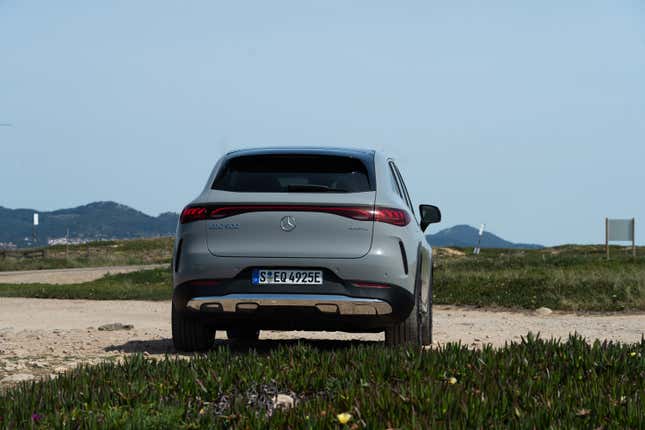
In exchange for the extra range (and an additional $11,600), the EQE SUV 500 4Matic gets you 402 hp and 633 lb-ft of torque. The 350 4Matic, meanwhile, gives you 288 hp and 564 lb-ft, while the single-motor, rear-drive EQE SUV 350+ nets you the same 288 hp but 417 lb-ft of torque. Both 4Matic variants of the EQE SUV feature new, quick-disconnect front driveshafts that allow the car to coast or gently accelerate without the parasitic drag of the front motor, but can still engage it under hard acceleration, regeneration, or when the rear wheels lose traction. Every EQE SUV also features a heat pump, which should make it far more efficient than the sedan when running the heater in cold weather.
Speaking of hard regeneration, while you can toggle between two regen modes using wheel-mounted paddles, even the “strong” setting is on the mild side, falling well short of the one-pedal experience that I (and a lot of EV drivers) prefer. Mercedes-Benz’s “Intelligent” regen mode is present as well, which uses the adaptive cruise-control logic to modulate regen based on traffic, but it’s clearly too smart for me. Despite spending many hours in many Mercedes EVs with this feature, I still don’t like it much.

I drove all three powertrains available on the EQE SUV. While the 500 certainly has the edge when it comes to urgency, both of the 350 models are plenty quick. Any of them leap forward in that time-honored EV way, but while the less-powerful cars seem to run out of steam at around 40 or 50 mph, the 500 will keep you planted in your seat well past the speed limit.
I love a quick car — we all do — but outright speed isn’t really what the EQS SUV is about. It has capable handling and oodles of grip, whether you go with the basic “comfort” suspension or the optional Airmatic adaptive setup, but with generous body roll and a somewhat relaxed reaction to steering inputs, it just isn’t a particularly enthusiastic dance partner. Keep it to a waltz, not a Charleston, and it’ll keep you smiling.
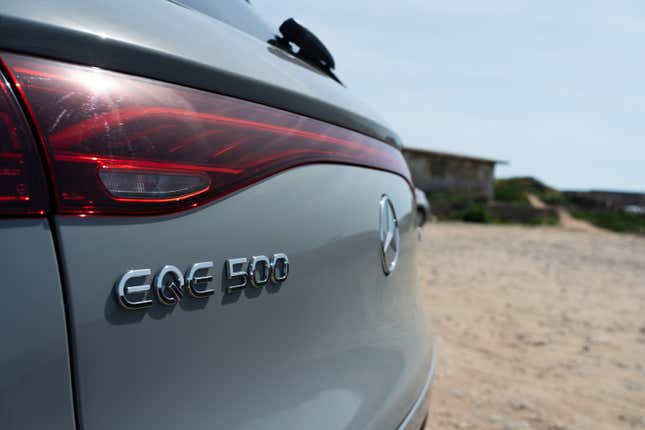
There is a Sport mode here, of course, and a customizable “Individual” mode as well, but far and away the best way to drive the EQE SUV is in Comfort. All EVs tend to be quiet, of course, but while some can let a lot of road noise or suspension complaints into the cabin, the EQE SUV just absorbs all that energy and channels it into another dimension. The ride quality and near-silence here are truly on another planet compared to EV crossovers like the Tesla Model Y or Ford Mustang Mach-E.
That just makes the EQE SUV a better platform to support the Burmester sound system with Dolby Atmos. There are upgrades available, but the base stereo sounds very good. You will, though, need to pay extra for some things that you might expect to come standard on a luxury EV, including adaptive cruise and, tragically, a heated steering wheel (a $250 option on the EQE sedan, too).
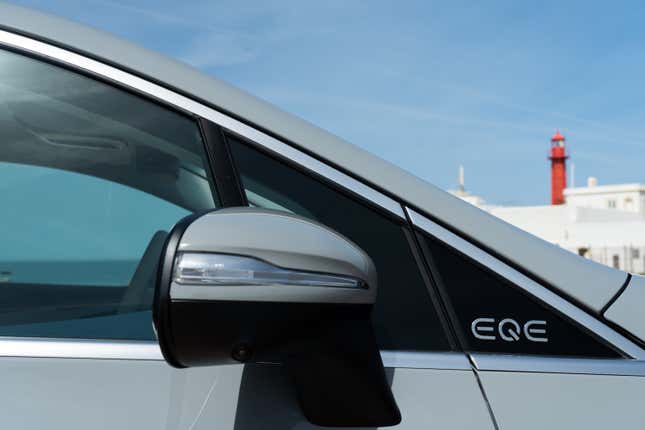
Just like how aerodynamics influence the EQE line’s anonymous exterior styling, the slight pain of missing standard features has a logical explanation: the U.S.’s draconian new EV tax incentives, which offer $7,500 off the sticker price of a qualifying electric SUV that costs $80,000 or less. The EQE SUV’s starting MSRP? $77,900 for the 350+, just under the line for eligibility. But check off more than a couple of options, and you can kiss that credit goodbye. Interestingly, the EQE SUV is the same price for either the rear-drive 350+ or the 4Matic, simplifying the decision somewhat: winter performance or maximal range?
It’s hard to stop yourself from checking a lot of option boxes — after all, that’s part of the fun of buying a luxury car (so I’ve been told). But regardless how you spec it, from base model to top-shelf with AMG Line styling, with the EQE SUV, you’re getting a smooth-driving, quick-accelerating, and good-looking all-electric crossover.
Well, better looking, anyway.